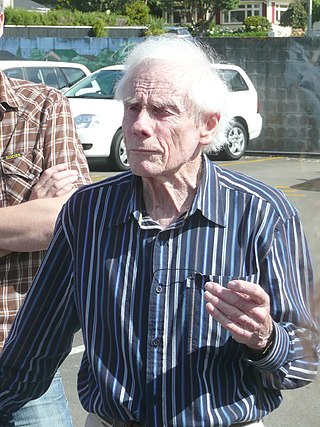
William Gray Young was a New Zealand architect in the early 20th century, designing buildings such as Knox College in Dunedin, the Wellington railway station and Wellington's Elliott House. He was president of the New Zealand Institute of Architects from 1935 to 1937.

Sir Frederick Miles Warren was a New Zealand architect. He apprenticed under Cecil Wood before studying architecture at the University of Auckland, eventually working at the London County Council where he was exposed to British New Brutalism. Upon returning to Christchurch, and forming the practice Warren and Mahoney, he was instrumental in developing the "Christchurch School" of architecture, an intersection between the truth-to-materials and structural expression that characterised Brutalism, and the low-key, Scandinavian and Japanese commitment to "straightforwardness". He retired from Warren and Mahoney in 1994 but continued to consult as an architect and maintain his historic home and garden at Ohinetahi.

Sir Ian Charles Athfield was a New Zealand architect. He was born in Christchurch and graduated from the University of Auckland in 1963 with a Diploma of Architecture. That same year he joined Structon Group Architects, and he became a partner in 1965. In 1968 he was a principal partner in setting up Athfield Architects with Ian Dickson and Graeme John Boucher. Athfield died in 2015 due to complications from a routine procedure which resulted in pneumonia, at the Wellington Hospital, where he was being treated for prostate cancer.

The National War Memorial of New Zealand is located next to the Dominion Museum building on Buckle Street, in Wellington, the nation's capital. The war memorial was dedicated in 1932 on Anzac Day in commemoration of the First World War. It also officially remembers the New Zealanders who gave their lives in the South African War, World War II and the wars in Korea, Malaysia and Vietnam.
Architecture of New Zealand is the built environment of regions, cities and towns of New Zealand.
William Hildebrand Alington was a New Zealand modernist architect, whose work was awarded nationally, and recognised internationally. He was the husband of New Zealand historian Margaret Alington.

Stanley William Toomath was a New Zealand architect who practised mainly in Wellington. He was a founding member of the Architectural Group in Auckland in 1946, a life member of the Wellington Architectural Centre and a Fellow of the New Zealand Institute of Architects. Both the founding of the Group and the Architectural Centre were important factors in New Zealand's modernist architectural history.
James Albert Beard was a New Zealand architect, town planner, and landscape architect.

Edmund Anscombe was one of the most important figures to shape the architectural and urban fabric of New Zealand. He was important, not only because of the prolific nature of his practice and the quality of his work, but also because of the range and the scale of his built and speculative projects. These extended from conventional essays to monumental urban schemes informed by his international travel, especially in America. His influence was specifically felt in Dunedin, Wellington, and the rebuild of Hastings following the 1931 Hawkes Bay Earthquake. He also realised projects in Alexandra, Invercargill, Palmerston, Palmerston North, Rotorua, Waimate North and Wanaka. His key works include the 1925–26 New Zealand and South Seas International Exhibition, the 1940 New Zealand Centennial Exhibition, the Herd Street Post and Telegraph building, Anscombe Flats, the Empire Deluxe theatre and his work on the clocktower complex – including specifically the Archway Building and Marama Hall – effectively re-conceiving the design of the University of Otago's historical core.(University of Otago Clocktower complex). His sister was painter Eliza Anscombe

The Dominion Museum building on Mount Cook in Buckle Street Wellington completed in 1936 and superseded by Te Papa in 1998 was part of a war memorial complex including a Carillon and National War Memorial.

The Bridge of Remembrance is one of two main war memorials in Christchurch, New Zealand. It is dedicated to those who died in World War I, and serves as a memorial for those who participated in two World Wars as well as subsequent conflicts in Borneo, Korea, Malaya, and Vietnam. Owned by Christchurch City Council, it is located on the Cashel Street Bridge at the head of City Mall. The Bridge of Remembrance was repaired and strengthened following the 2011 Christchurch earthquake and was reopened with a rededication ceremony held on Anzac Day in 2016.

Cecil Walter Wood was a New Zealand architect. He was the dominant architect in Canterbury during the interwar period.
Francis Gordon Wilson was an Australian-born New Zealand architect. Wilson oversaw the design of New Zealand’s state housing programme from the 1930s onwards. He was the New Zealand Government Architect at the time of his death.
John Thomas Mair was a New Zealand architect. From 1923 until his retirement in 1941 he held the position of Government Architect.

William Henry Gummer was a New Zealand architect.
Milan Mrkusich was a New Zealand artist and designer. He was considered a pioneer of abstract painting in New Zealand. Retrospective exhibitions of his work were organised by the Auckland Art Gallery in 1972 and 1985, and at the Gus Fisher Gallery in 2009. A substantial monograph was published by Auckland University Press in 2009.

The William Booth Memorial Training College is a building on Aro Street, in Aro Valley, Wellington, New Zealand, which currently houses the School of Practical Philosophy and Meditation. It was completed in 1913, and named after one of the founders of the Salvation Army, William Booth.

The Cenotaph in the southern New Zealand city of Dunedin stands in the centre of Queens Gardens, close to the city centre. It is the city's main war memorial.

Hoggard, Prouse and Gummer was an architectural firm that operated between 1913 and 1921 in Wellington, New Zealand. The partners were John Hoggard, William Prouse and William Henry Gummer.

Laurence Jeremy Elder Salmond was a New Zealand conservation architect. He received the NZIA Gold Medal, the highest honour in New Zealand architecture, in 2018.



















